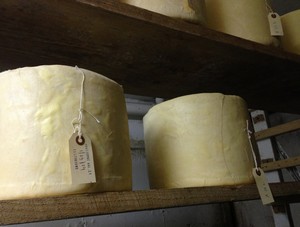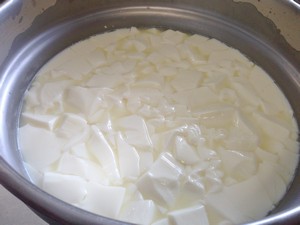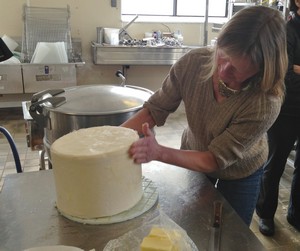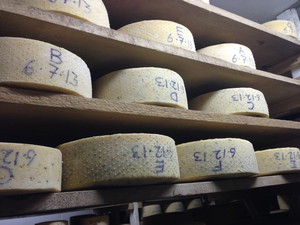 As you may know, the Accidental Locavore has been wanting to make cheese for a while now, so when the opportunity came up to take a cheddar-making class I quickly signed up. Because of time constraints, most cheese-making classes are limited to making ricotta, goat cheese or mozzarella (two out of three of which I’ve made). This one, at Hawthorne Valley Farm, was different because Peter, the cheesemaker, had figured out how to show us cheddar-making in its various phases. And who wouldn’t want to make cheddar?
As you may know, the Accidental Locavore has been wanting to make cheese for a while now, so when the opportunity came up to take a cheddar-making class I quickly signed up. Because of time constraints, most cheese-making classes are limited to making ricotta, goat cheese or mozzarella (two out of three of which I’ve made). This one, at Hawthorne Valley Farm, was different because Peter, the cheesemaker, had figured out how to show us cheddar-making in its various phases. And who wouldn’t want to make cheddar?
When we arrived at the farm, Peter showed us a batch that he started a few hours before and we got to work on a second batch. In real time it can take up to 9 hours to make a batch, so time and patience are some of the prerequisites to good cheese. The other, and most important, is a source for good (preferably raw) milk. Add to that a proper place to age your cheeses and you come up with a pretty daunting list of hurdles before you even start.
 Peter was great about explaining the whole process, which is essentially heating the milk, adding cultures (that’s what flavors the cheddar), adding rennet (that’s what makes it cheese), cutting the curds and then separating them from the whey. Even when he was getting very technical, it was in an easily understandable way, and not so over-your-head that you glaze over and stop paying attention, which was pretty impressive. Because of that, we learned a lot about the composition of milk, how cultures are made, the differences in rennet and how they all combine to make (or break) cheese.
Peter was great about explaining the whole process, which is essentially heating the milk, adding cultures (that’s what flavors the cheddar), adding rennet (that’s what makes it cheese), cutting the curds and then separating them from the whey. Even when he was getting very technical, it was in an easily understandable way, and not so over-your-head that you glaze over and stop paying attention, which was pretty impressive. Because of that, we learned a lot about the composition of milk, how cultures are made, the differences in rennet and how they all combine to make (or break) cheese.
 When the cheese was finished and molded, we learned how to wrap, using a big cheddar that they had made the day before. Now I understand why clothbound cheddars are my favorite — butter! First, you coat it in butter, apply the wrap, and then add more butter to make the wrap stick to the cheese — yum! After that it goes into the cheese cellar for at least six months before you can see how your adventure turned out. We got to accompany our wheel into the cellars and tour the various areas. So there is no co-mingling of bacteria, each type of cheese is aged in a separate area.
When the cheese was finished and molded, we learned how to wrap, using a big cheddar that they had made the day before. Now I understand why clothbound cheddars are my favorite — butter! First, you coat it in butter, apply the wrap, and then add more butter to make the wrap stick to the cheese — yum! After that it goes into the cheese cellar for at least six months before you can see how your adventure turned out. We got to accompany our wheel into the cellars and tour the various areas. So there is no co-mingling of bacteria, each type of cheese is aged in a separate area.
Now, I know you’re all wondering, have I made a cheddar yet? No, for a couple of reasons. First, getting raw milk requires a car trip, which has been a bit difficult due to our nasty winter. Secondly, I’m waiting for the installation of a new gas range, which will make it easier to control the temperature of the milk — a critical aspect. So it may become a rainy day spring or summer project, but I’ll let you know.

The other class they sometimes offer is for making feta. I’ll let you know and you can tell the goat Spinners. See you this summer!
Neat presentation, Ann. The Spinners are meeting this AM at the house/barn right across from the old library in Tenants Harbor-(wearing “grippers” after last night’s ice storm ) .In the barn , there’s a Jersey cow and calf. Three
Spinners are cheese makers with goats -Joan has the only cow. They’re all Master Gardeners.
Now, I’ll have something to contribute. Best to Frank, N.